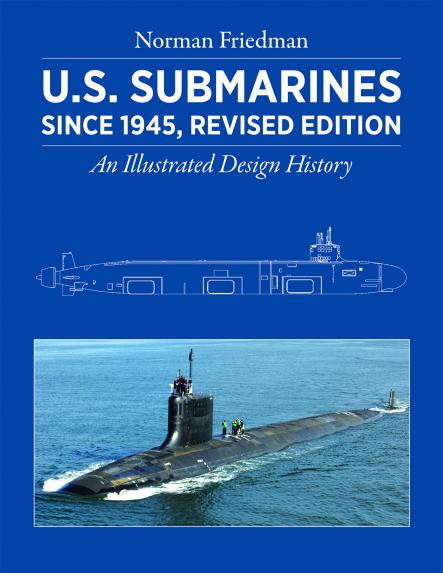
US Submarines since 1945, Revised Edition: An Illustrated Design History. By Norman Friedman. Naval Institute Press, Annapolis MD, 2018.
Reviewed by Dr Gregory P. Gilbert
IN 1994 the United States Naval Institute Press published Norman Friedman’s ground-breaking work on ‘U.S. Submarines since 1945’. Now over 20 years later we have Norman’s updated work in the 2018 ‘Revised Edition’. That the original work was a tour de force is only confirmed by the way that much of the first edition has demonstrated its relevance today. Now with a modernised last chapter, up to date appendices with updated notes and additional new information, we once again have a masterful rendering of modern submarine technology.
As usual Norman Friedman provides much more than a design history of US submarines, he explains how and why the best designed submarines in the world have changed over the last 70 years.
With over 300 pages of detailed text and more than 200 photographs and drawings, ‘U.S. Submarines Since 1945’ provides the only accurate source available to professionals of the submarine, underwater warfare and engineering community. As usual Norman writes in a clear, concise and highly informative manner, which may be denser than an average reader may desire. Beginners should perhaps look elsewhere to introductory book on submarines, but anyone who wishes to actually understand submarine operations, requirements, research and development, design and technology cannot avoid reference to this excellent work.
Some might believe that Australians have very little to learn from the US submarine design experience. They would be fundamentally wrong. Recent experience with submarine design and build for the Royal Australian Navy has demonstrated that many of the lessons that were identified by the US Navy since 1945 remain very relevant for Australian submarines. It would be as courageous to ignore the influences of US submarines when they are the best versions of their type anywhere in the world, as it would be to ignore the influences of British dreadnought designs before 1914. The world’s best navies always generate advanced engineering and technological capabilities that other lesser navies cannot hope to repeat. This is as true for conventional powered submarines as it is for nuclear powered ones.
However, perhaps the most enduring lesson to be learnt from the US submarine design history is that the ability to successfully meet operational requirements is invariably linked to a continuous shipbuilding enterprise. This has become clear to the US Navy since the end of the Cold War. Although the LOS ANGELES class submarines, designed in the early 1970s, were amongst world’s best submarines they were clearly in need of replacement by the mid-1980s when the SEAWOLF class SSNs were being designed. But in order to gain the so-called ‘Peace Dividends’ of the early post-Cold War period only three SEAWOLF submarines were ordered: the last commissioned in 2006. In the meantime a smaller and cheaper SSN, to become the VIRGINIA class, were designed in the late 1990s. Even though the VIRGINIA SSNs now being built are an excellent submarine, especially for littoral missions, the cost of the major disruption to the related US submarine design continuous improvement programs was probably not worth the short term savings caused by the disruptions. Overall it is important to recognise that the US submarine design philosophy has evolved over many years of continuous intellectual endeavour. The stop-start approach, experienced during the early 1990s for instance, did not lead to an open-mindedness in the design approach as this was already evident before the cuts. In fact the cuts inevitably led to a considerable loss of submarine design expertise and the later need to relearn some of the design methodologies at significant additional cost.
So why is this book important for Australians? As this nation is once again commencing a multi-Billion dollar new submarine project we find that we do not build upon the submarine design philosophies of the past. With the Royal Navy’s OBERON class and even the RAN Submarine Weapons Upgrade Project (SWUP) of the 1980s Australia relied upon the British submarine design philosophy and the associated support. For the RAN COLLINS class submarines of the 1990s Australia initially relied upon the Swedish submarine design philosophy, which was remarkably different from what we were used to, and associated support arrangements. Of course some US submarine design approaches were required in the early 2000s in order to better meet the actual 21st century requirements. For our next generation of submarines into the 2020s Australia will rely upon the French submarine design philosophy, which again is likely to be remarkably different from our earlier experiences. For each of these three national submarine enterprises we have no ‘illustrated design histories’ like that presented by Norman Friedman for the US submarines, and hence Australian’s are largely left to catch-up individually if at all.
Overall ‘U.S. Submarines since 1945, Revised Edition’ by Norman Friedman is a must read for all professionals, designers and scholars of modern submarines. Although it may seem revolutionary to some, this book should be on the recommended reading list for Australian submarine design courses. One day we may even get an illustrated design history on Australian submarines but I would imagine that, as much of the evidence has been already lost in order to hide the truth.



